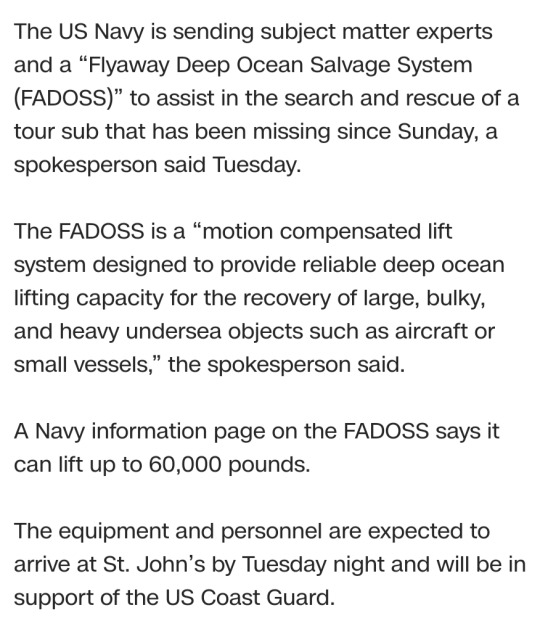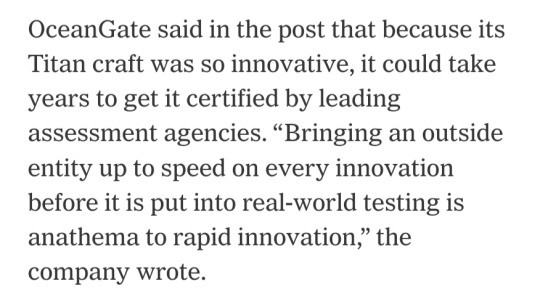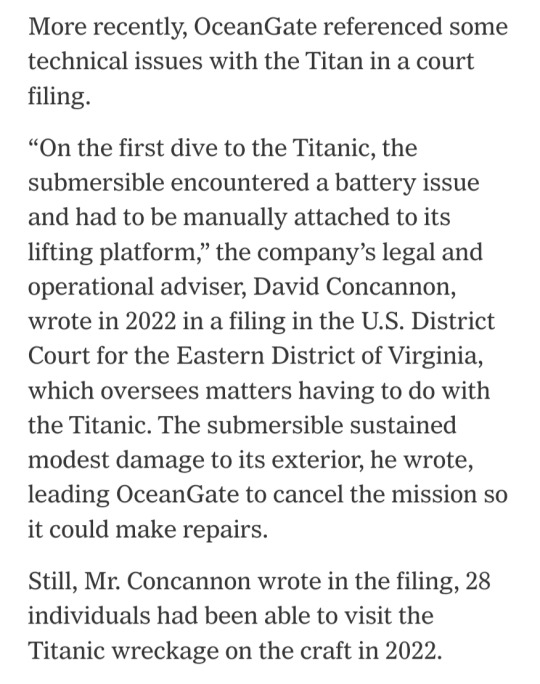#Offshore support vessel market
Text
Global offshore support vessel market is expected to reach the market valuation of approximately US$ 28 billion by 2030 expanding at a reasonable CAGR of above 5% during the forecast period.
0 notes
Text
Chicago, Jan. 31, 2024 (GLOBE NEWSWIRE) -- The global Offshore Support Vessel Market size is projected to grow from USD 22.6 billion in 2023 to USD 31.4 billion by 2028, at a CAGR of 6.7% according to a new report by MarketsandMarkets™.
#offshore support vessel#offshore support vessel (OSV)#offshore support vessel market#offshore vessel#offshore supply#offshore energy#offshore oilfield#offshore oilrig#offshore oil and gas#offshore oil#offshore drilling#offshore oilwell#offshore platform#offshore decommissioning#offshore pipeline#offshore wind#offshore rig#offshore company formation#offshore outsourcing#offshore#energy#energia#oilfield#oil and gas industry#oilfields#oil and gas#oil#oil well
0 notes
Text
The global Offshore Support Vessel Market is projected to reach USD 31.4 billion by 2028 from USD 22.6 billion in 2023 at a CAGR of 6.7% according to a new report by MarketsandMarkets™.
#offshore companies#offshore outsourcing#offshore services#offshore drilling#offshore#offshore oil rig#offshore support vessel market#offshore support vessel#offshore systems#offshore supply#offshore supply vessel#offshore vessels#offshore vessel#energy#oil and gas#oil and gas industry#offshore oil and gas#offshore oil#offshore pipelines#offshore platform#offshore energy#offshore wind farm#offshore wind#offshore wind power#oil and gas exploration#oil and gas companies
0 notes
Text
Offshore Support Vessel Market to record robust growth rate in coming 10 years | Bourbon, Grupo CBO, Gulfmark
Global Offshore Support Vessel Market report from Global Insight Services is the single authoritative source of intelligence on Offshore Support Vessel Market. The report will provide you with analysis of impact of latest market disruptions such as Russia-Ukraine war and Covid-19 on the market. Report provides qualitative analysis of the market using various frameworks such as Porters’ and PESTLE analysis. Report includes in-depth segmentation and market size data by categories, product types, applications, and geographies. Report also includes comprehensive analysis of key issues, trends and drivers, restraints and challenges, competitive landscape, as well as recent events such as M&A activities in the market.
An offshore support vessel (OSV) is a type of ship that is used to provide logistic and supply support to offshore oil and gas platforms. These vessels are typically equipped with cranes, winches, and other heavy-duty machinery that is used to transport supplies and personnel to and from the offshore platform. OSVs can also be used for other purposes such as environmental monitoring, search and rescue, and disaster relief.
Request Sample Report – https://www.globalinsightservices.com/request-sample/GIS20565/
Key Trends
Offshore support vessel (OSV) technology is constantly evolving in order to meet the demands of the oil and gas industry. The most significant trend in OSV technology is the move towards larger and more sophisticated vessels. This is being driven by the need for increased capacity and performance in order to support the ever-growing offshore oil and gas industry. Larger vessels are able to carry more cargo and fuel and have the ability to stay at sea for longer periods of time. They are also equipped with more advanced technologies, such as dynamic positioning systems, which allow them to maintain a constant position in rough seas.
Key Drivers
The key drivers of the offshore support vessel market are the increasing exploration and production activities in the offshore oil and gas industry, the need for cost-effective and efficient transportation of goods and personnel to offshore oil and gas fields, and the increasing demand for environmental friendly and fuel efficient vessels. The offshore oil and gas industry is undergoing a period of rapid expansion, driven by the increasing demand for energy and the need to find new sources of oil and gas. This has led to an increase in exploration and production activities in the offshore oil and gas industry, which in turn is driving the demand for offshore support vessels.
Market Segmentation
By Type
Anchor Handling Towing Supply Vessel
Platform Supply Vessel
Fast Supply Intervention Vessel
By Water Depth:
Shallow Water
Deepwater
Breakup by Fuel:
Fuel Oil
LNG
By Service Type:
Technical Services
Inspection & Survey
By Application:
Oil and Gas
Request For Customization – https://www.globalinsightservices.com/request-customization/GIS20565/
Key Players
Bourbon
Grupo CBO
Gulfmark
Havila
Maersk
Seacor Marine
SIEM Offshore
Solstad
With Global Insight Services, you receive:
10-year forecast to help you make strategic decisions
In-depth segmentation which can be customized as per your requirements
Free consultation with lead analyst of the report
Excel data pack included with all report purchases
Robust and transparent research methodology
Ground breaking research and market player-centric solutions for the upcoming decade according to the present market scenario
About Global Insight Services:
Global Insight Services (GIS) is a leading multi-industry market research firm headquartered in Delaware, US. We are committed to providing our clients with highest quality data, analysis, and tools to meet all their market research needs. With GIS, you can be assured of the quality of the deliverables, robust & transparent research methodology, and superior service.
Contact Us:
Global Insight Services LLC
16192, Coastal Highway, Lewes DE 19958
E-mail: [email protected]
Phone: +1–833–761–1700
0 notes
Text
India offshore support vessel market is projected to grow at a double-digit CAGR during the forecast period, FY2024-FY2031.
0 notes
Text
Waves of Opportunity: Offshore Support Vessel Market Trends
Offshore support vessel market transport goods, supplies, and major equipment during exploration and production of offshore mineral resources. These vessels are operated by ship owners and are utilized to locate oil & gas bearing areas, towing rigs, and platforms, and positioning them. These vessels are also deployed in subsea operations such as inspection, diving support, and maintenance. Moreover, other facilities provided include transportation, standby capacity, anchor management, and platform support. It also enables in moving the crew members to offshore sites.
This report projects the trends and opportunities of the global offshore support vessel market. This research study includes a qualitative and quantitative analysis with comprehensive research methodologies and reliable projections to understand the present overview and predict the market behavior during the forecast period.
Rise in offshore exploration and production activities drive the offshore support vessel market. Moreover, increase in capital expenditure on offshore oil exploration further leads to offshore developments. The market is projected to grow at a higher rate during the analysis period owing to the rise in demand for oil & gas. However, high replacement and maintenance cost of these vessels hamper the market growth. In addition, lack of technical professionals in the offshore industry also restricts the growth.
The global offshore support vessel market is segmented based on type, depth, and geography. On the basis of type, it is divided into anchor handling tug supply, platform supply vessel, multipurpose support vessel, standby & rescue vessel, crew vessel, chase vessel, and seismic vessel. On the basis of depth, the market can be bifurcated into shallow water and deep water. Geographically, it is analyzed across North America, Europe, Asia-Pacific, and LAMEA.
Key market players in this sector include Rem Maritime As, Bass Marine Pty Ltd., Harvey Gulf, Island Offshore Management, Havila Shipping ASA, and Intermarine LLC, Grupo Coremar S.A., Delta Logistics Limited, Deep Sea Supply PLC, Bumi Armada Berhad, Topaz Energy, and Marine Limited.
Key Benefits for Stakeholders
This report provides a quantitative analysis of the current trends, estimations, and dynamics which assists to identify the prevailing market opportunities.
Major countries in each region are studied as per the key trends developments, and presence of industry players in the market.
Region-wise and country-wise market conditions are comprehensively analyzed in the report.
Key players of the market are also listed.
This study evaluates the value chain to understand the competitive environment across geographies.
An in-depth analysis of segmentation is provided to elucidate the prevailing market opportunities.
Key Market Players : Delta Logistics Limited, Island Offshore Management, Harvey Gulf, Havila Shipping ASA, Deep Sea Supply PLC, Rem Maritime As, Bumi Armada Berhad, Grupo Coremar S.A., Bass Marine Pty Ltd., Intermarine LLC
0 notes
Link
#market research future#offshore support vessels#supply vessel spot market#offshore supply vessel market#offshore vessel charter rates
0 notes
Text
Global Offshore support vessel services Market by Vessel Type - Platform Supply Vessel (PSV) | Multirole field & ROV Support Vessel (MRSV) | Offshore Subsea Construction Vessel (OSCV) | Anchor Handling Tug Supply (AHTS) | Emergency Response and Rescue Vessels (ERRSV) | Chase & Seismic Vessels | Standby Crew Vessels
0 notes
Link
North America Offshore Support Vessels Market is poised to grow at CAGR of 2 % by 2027. Factors driving North America Offshore Support Vessels Market are less period of investment return from offshore and upcoming offshore wind farm projects in countries such as the United States and Canada.
#north america offshore support vessels market#north america offshore support vessels market outlook#north america offshore support vessels market size#north america offshore support vessels market share#north america offshore support vessels market forecast#north america offshore support vessels market report
0 notes
Link
The United States offshore support vessels market is expected to exhibit moderate growth during 2021-2026.
#United States Offshore Support Vessels Market Share#United States Offshore Support Vessels Market Trends#United States Offshore Support Vessels Market Growth
0 notes
Text
the most recent development in the case of the missing Titan submersible is that the U.S. Navy has now officially been brought in to assist on the search. earlier it was reported that they were looked at being brought in but are now involved. while the U.S. Coast Guard was focusing mainly on the surface of the water in the search for the sub, the search is now taking place underwater as well. from CNN:

The US Navy is sending subject matter experts and a “Flyaway Deep Ocean Salvage System (FADOSS)” to assist in the search and rescue of a tour sub that has been missing since Sunday, a spokesperson said Tuesday.
The FADOSS is a “motion compensated lift system designed to provide reliable deep ocean lifting capacity for the recovery of large, bulky, and heavy undersea objects such as aircraft or small vessels,” the spokesperson said.
A Navy information page on the FADOSS says it can lift up to 60,000 pounds.
The equipment and personnel are expected to arrive at St. John’s by Tuesday night and will be in support of the US Coast Guard.
the other piece of news: there is only about 40 hours of breathable air left. also per CNN:

The Coast Guard said Tuesday that the search has not yielded anything so far, but it is continuing to look both on the surface and underwater for the missing submersible. Officials estimated that the crew onboard has "about 40 hours of breathable air left."
for those curious as to how something like this could even be ok'ed, know that others had doubts about what OceanGate was doing, too.
as reported by The New York Times, in 2018 Stockton Rush, CEO of OceanGate, by the Marine Technology Society's Manned Underwater Vehicles committee. the group itself is a 60-year old trade group that, according to their website, "promotes awareness, understanding, and the advancement and application of marine technology."
the letter itself was signed by more than three dozen people, which comprised of "oceanographers, submersible company executives and deep-sea explorers", had stated their "unanimous concern" in regards to the Titan submersible. today, Tuesday, chairman of the committee Wil Kohnen said the letter was written because of fears that presumably he and the others had about what could happen if a company is not held to industry standards. quote from Kohnen in the Times:

“The submersible industry had significant concerns over the strategy of building a deep sea expedition submersible without following existing classification safety guidelines,” Mr. Kohnen said.
according to the letter, they said that OceanGate's marketing of the Titan sub as claiming it would "meet or exceed the safety standards" of the DNV - by their website they are "the world’s leading classification society and a recognized advisor for the maritime industry"; they are to maritime vessels, vehicles, and offshore units what the DMV is to cars, trucks, etc., more or less - as "misleading." indeed, OceanGate had no plans to have the Titan assessed by the DNV.
Stockton Rush called Kohnen after receiving and reading the letter, and stated that "industry regulations were stifling innovation." they would later reiterate this stance in a 2019 blog post about why the Titan wasn't classed (which can be found here, for now).

OceanGate said in the post that because its Titan craft was so innovative, it could take years to get it certified by leading assessment agencies. “Bringing an outside entity up to speed on every innovation before it is put into real-world testing is anathema to rapid innovation,” the company wrote.
the company was aware, however, that the Titan had issues. once again, per the NYT:

More recently, OceanGate referenced some technical issues with the Titan in a court filing.
“On the first dive to the Titanic, the submersible encountered a battery issue and had to be manually attached to its lifting platform,” the company’s legal and operational adviser, David Concannon, wrote in 2022 in a filing in the U.S. District Court for the Eastern District of Virginia, which oversees matters having to do with the Titanic. The submersible sustained modest damage to its exterior, he wrote, leading OceanGate to cancel the mission so it could make repairs.
Still, Mr. Concannon wrote in the filing, 28 individuals had been able to visit the Titanic wreckage on the craft in 2022.
despite these issues with the Titan being brought up and essentially brushed away by OceanGate, issues having been brought up for years now, in retrospect it seems something like this happening was simply inevitable.
#long post#titan sub update#that's gonna be my tag for this I'm gonna keep making update posts every couple hours
21 notes
·
View notes
Text
The global Offshore Support Vessel Market is projected to reach USD 31.4 billion by 2028 from USD 22.6 billion in 2023 at a CAGR of 6.7% according to a new report by MarketsandMarkets™. An offshore support vessel (OSV) is specially designed to support offshore exploration, drilling, production, and construction activities in the oil & gas industry.
#offshore oil and gas#offshore decommissioning#offshore drilling#offshore company formation#offshore outsourcing#energy#energia#Offshore support vessel#Offshore support vessel market#osv#osv market#Offshore vessel#Offshore rig#offshore#offshore oilfield#offshore oilrig#offshore energy#offshore oil#offshore wind
0 notes
Text
Jun 05, 2023 (AB Digital via COMTEX) --
The global Offshore Support Vessel Market is projected to reach USD 31.4 billion by 2028 from USD 22.6 billion in 2023 at a CAGR of 6.7% according...
#offshore supply vessel#offshore supply#offshore support vessel#offshore support vessel market#offshore companies#offshore outsourcing#offshore services#offshore drilling#offshore#offshore oil rig#offshore oil and gas#offshore oil#offshore pipelines#offshore platform#offshore drilling rigs#offshore decommissioning#offshore rig#offshore energy#offshore vessels#offshore vessel#marine#maritime#offshore exploration
1 note
·
View note
Text
Navigating the Skies: Unveiling the Trajectory of Vessel Traffic Management Market Growth
The Vessel Traffic Management (VTM) Market is poised for substantial growth, with a projected increase from USD 5.8 billion in 2022 to USD 8.7 billion by 2027, indicating a robust Compound Annual Growth Rate (CAGR) of 8.4% during the forecast period.
Driven by the dynamic nature of the shipping business and the continuous evolution of maritime operations, the demand for technologically advanced VTM systems is on the rise. These systems play a crucial role in enhancing safety, efficiency, and environmental protection within marine traffic management.
Download PDF Brochure: https://www.marketsandmarkets.com/pdfdownloadNew.asp?id=226816165
Market Trends:
Technological Advancements: The market is witnessing a shift towards technologically advanced systems for port management, onshore and offshore traffic management, and navigational support. Radar, RF communication, VHF communication, and Automatic Identification System (AIS) are integral components utilized in modern VTM systems to monitor vessel movements and provide navigation aid to crew members.
Strategic Collaborations and Investments: Key players in the VTM market are adopting strategic initiatives such as contracts, agreements, investments, new product launches, and acquisitions to strengthen their market position. For instance, Saab secured a contract to supply Halifax Port Authority with a Port Management Information System (PMIS), demonstrating the strategic importance of technology partnerships in this sector.
Industry Insights:
The VTM industry is characterized by the presence of major players such as Kongsberg Gruppen, Wärtsilä, Thales Group, Leonardo S.p.A., and Saab SA. These companies offer comprehensive VTM solutions and services to various stakeholders, including port authorities, maritime organizations, and shipping companies.
Kongsberg Gruppen: With a focus on technology and innovation, Kongsberg Gruppen provides onshore and offshore solutions, merchant marine services, subsea solutions, and naval systems. Its C-Scope solution enhances maritime domain awareness, improving efficiency and safety in operating areas.
Wärtsilä: Positioned as a smart technology company, Wärtsilä offers customizable solutions for port and vessel traffic management, ensuring seamless maritime traffic control, vessel monitoring, and just-in-time arrivals through innovative data handling methods.
Thales Group: Thales Group specializes in aerospace, defense, transportation, and security solutions. Its maritime traffic safety systems integrate vessel traffic services, providing European and export military clients with sensors, mission systems, communications, and control systems.
Leonardo S.p.A.: Formerly known as Leonardo-Finmeccanica, Leonardo S.p.A. specializes in aerospace and defense technology. Its Vessel Traffic Management System (VTMS) integrates assets for safe and secure maritime operations, including traffic management, environmental preservation, law enforcement, and port security.
Saab SA: Saab is a leading aerospace and defense company offering maritime traffic management solutions for military defense and civic security industries. Its Naval segment provides extensive products and solutions for maritime traffic management globally.
Inquiry Before Buying: https://www.marketsandmarkets.com/Enquiry_Before_BuyingNew.asp?id=226816165
The Vessel Traffic Management (VTM) Market is characterized by intense competition and rapid technological advancements, driving players to innovate and collaborate to meet the evolving demands of the maritime industry.
About MarketsandMarkets™
MarketsandMarkets™ has been recognized as one of America's best management consulting firms by Forbes, as per their recent report.
MarketsandMarkets™ is a blue ocean alternative in growth consulting and program management, leveraging a man-machine offering to drive supernormal growth for progressive organizations in the B2B space. We have the widest lens on emerging technologies, making us proficient in co-creating supernormal growth for clients.
Contact:
Mr. Aashish Mehra
MarketsandMarkets™ INC.
630 Dundee Road, Suite 430, Northbrook, IL 60062
USA: +1-888-600-6441
Email: [email protected]
0 notes
Link
#market research future#offshore support vessels#supply vessel spot market#offshore supply vessel market#offshore vessel charter rates
0 notes
Text
Floating Power Plant Market: Trend Analysis 2023-2030

Floating power plants are a viable solution for powering island countries at lower costs than laying subsea cables. They can be installed on vessels like ships or barges, harnessing renewable energy sources such as solar, wind, hydro, and liquefied natural gas. The increasing demand for electricity in island countries drives their adoption, while complexities and environmental concerns with floating nuclear power plants may hinder the market growth. However, growing investments by Asian countries like India, Japan, Australia, and China in deploying plants with diverse energy sources offer ample opportunities for market players in the Asia-Pacific floating power plant market.
The global floating power plant market has seen growth in recent years, engaging the attention of various industries and stakeholders. In terms of revenue, the market is valued at $10,010.11 million in 2022 and is projected to grow at a CAGR of 10.74% throughout the forecast period.
Ship-based Floating Power Plants: Key Prospect
Floating power plants on ships are gaining popularity due to their flexibility, mobility, and ability to deliver electricity to remote or disaster-stricken areas. They are also ideal for coastal regions with limited land availability. Moreover, these power plants utilize renewable energy sources like solar and wind power, contributing to the global shift towards clean energy. Their modular design allows scalability and easy relocation to meet changing energy demands. Ship-based floating power plants have made significant technological advancements, improving their efficiency, scalability, and adaptability to marine environments.
One notable example is Karpowership, a Turkish company specializing in ship-based energy solutions. They have developed power barges installed on converted cargo ships, capable of generating electricity in various locations. These power plants have seen improvements in power generation, fuel efficiency, and environmental impact reduction thanks to more efficient gas turbine engines and advanced energy management systems. The modular systems Karpowership developed enable quick power capacity expansion by integrating additional barges.
Floating power plants on ships are now widely used for emergency power during natural disasters, temporary power generation in remote areas, and construction projects. They are particularly valuable in regions where fixed offshore wind farms are not feasible, allowing the utilization of wind energy in deeper waters. West Africa, specifically Ghana, is witnessing a resurgence in ship-based floating power plants to address energy challenges in remote coastal areas and islands. Karpowership has successfully deployed these plants in Ghana, providing reliable and flexible power generation, supporting the country's energy infrastructure, and driving economic growth.
The Green Initiative Effect
Ship-based floating power plants use renewable energy sources to generate electricity. These energy sources renew naturally within a human period, making them sustainable and environmentally friendly alternatives to traditional fossil fuel power generation. Using these plants based on renewable energy offers several advantages over land-based plants. They can be easily transported and relocated to areas with high energy demand or limited land availability.
In 2020, 38% of electricity in the European Union was generated from green energy, with wind energy being the most widely used renewable energy source. Hydropower and solar energy also contribute significantly to the renewable energy mix.
As per the Triton Market Research, the renewable segment is expected to grow with the fastest CAGR of 11.20% during the forecast period. This is attributed to the increasing global awareness and adoption of clean energy sources, government incentives, and advancements in renewable technologies.
OEMs: Powering the Future with Innovation
OEMs play a central role in floating power plants on ships because they provide the necessary expertise, technology, and equipment to design, build, and integrate power generation systems onto the ships. Working closely with project developers, they deliver customized solutions that meet specific requirements. By supplying high-quality components, OEMs ensure seamless integration of renewable energy and increase efficiency and reliability for the overall success of green energy initiatives.
Leading industry players like ABC Power System and XYZ Renewable Solutions drive the market forward with innovative technologies. The Hywind Scotland project, the first commercially viable floating wind farm, showcases the scalability and adaptability of power plants in deep offshore areas where fixed-bottom turbines are not feasible.
Conclusion
The floating power plant market has innovated sustainable solutions to meet the growing electricity demand. With the help of OEMs, these power plants can be designed, built, and integrated into ships to provide a reliable energy source. As the world moves towards cleaner and more sustainable energy sources, these plants have the potential to play a significant role in meeting our energy needs while reducing our carbon footprint. They offer a flexible and efficient way to generate electricity, making them an attractive option for the future.
FAQs:
Q1: What factors are restraining the market growth?
High upfront costs, complex regulatory frameworks, and challenges associated with grid integration & infrastructure development are key restraints to the market.
Q2: What segments are analyzed in the floating power plant market?
Segment by capacity (0 MW-5 MW, 5.1 MW-20 MW, 20.1 MW-100 MW, 100.1 MW-250 MW, and, above 250 MW) and source (non-renewable power source and renewable power source).
Q3: What geopraphies are studied in the market?
North America, Europe, Asia-Pacific, Latin America, and Middle East & Africa.
#Floating Power Plant Market#Power Plant Market#Floating Power Plant#triton market research#market research report
0 notes